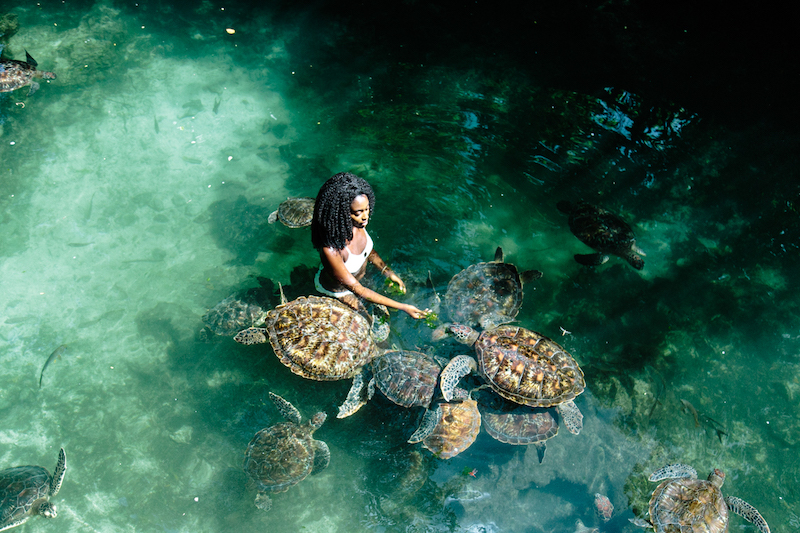Combo excursion to swim with turtles
Zanzibar turtle sanctuary swim with turtles in Zanzibar natural lagoon, with a guide. During the visit you can also feed turtles with sea weed or just spend your time in the water with them . Also you can take snorkeling mask to dive and watch them in their natural environment.
What's included
- Transportation from Nungwi/Kendwa area
- Entry fees
- Guide
- Sea weed
Other activities in Zanzibar

About the Turtle Sanctuary
Natural Aquarium – Nungwi is a home endangered sea turtles and a variety of fish. The aquarium itself is a natural formation carved out from the coral bedrock by the erosion of millions of waves crashing against the shore. The depth of the water rises and falls with the tides providing a natural environment for its inhabitants. You might also wonder to see how the local boats are made, how the fishnets and sails are repaired. Lunch and refreshments are arranged there to taste local delicacies or international food. This is the best trip that gives you the scope to discover the life of local fishermen of the island. After the walk, you can either relax on the sandy beaches or go swimming in the natural sea.
Turtles Zanzibar FAQ
Zanzibar swim with turtles location is Nungwi (northern island)
Turtles in Zanzibar: There are mainly 2 species of marine turtles in Zanzibar’s waters.Green & hawksbill turtles. Wide spread at Nungwi/Mnemba northern Zanzibar
The green turtle is the most common and widespread species in Tanzania. While low density nesting has been reported along the mainland coast from Tanga in the north to Mtwara in the south, the most concentrated numbers of nests appear to be on the offshore islands of Zanzibar
Hawksbills are also widely distributed but are less abundant. Nesting has only been recorded in low numbers on small remote offshore islands such as Misali and Mnemba Islands in Zanzibar.
The main threats to turtles in Tanzania are disturbance of nesting and foraging habitats, incidental net captures (gillnets and trawlers), poaching of meat and eggs, lack of adequate protection and enforcement, limited awareness and land-based development and pollution.
Recommendations for research and monitoring include: further studies on turtle reproduction, nest biology, foraging habitats, genetics and threats; and tagging to determine movements and breeding frequency.
Conservation and management priorities include: protection of key habitats, compulsory use of Turtle Excluder Devices by commercial prawn trawlers and restriction of gillnets in key foraging areas; promotion of community participation in the management of coastal and marine resources through recruitment of Community Turtle Monitors and involvement in Beach Management Units; awareness raising; development of a Turtle Recovery & Action Plan; coordination of activities at national and regional levels by the National Turtle Conservation Committee; and fund raising.
Nungwi, or Ras Nungwi, is a large village located in the far northern end of the island of Zanzibar. With a population of about 5,563, Nungwi is the second- or third-largest settlement on the island. Nungwi was traditionally a fishing village and dhow-building center, but is now a popular tourist destination, and for instance recognized in CNN’s list of “100 best beaches of the world” in 2014 with numerous resorts, restaurants, bars, stores, etc.
-They’re really ancient
The oldest known sea turtle fossil is at least 120 million years old, making sea turtles some of the oldest creatures on the planet. That means they shared the planet with dinosaurs which became extinct around 65 million years ago.
-Turtle tears
Turtles do cry, but not because they’re sad. They have glands that help to empty excess salt from their eyes, which makes it look like they’re crying.
-Staying alive
They live to around 100 years, which is also roughly the number of eggs female sea turtles lay when they nest.
-They can hold their breath for five hours underwater.
To accomplish this mighty feat they slow their heart rate to up to nine minutes in between heart beats in order to conserve oxygen.
–TURTLES DON’T HAVE TEETH
They use their beak-like mouth to grasp their food. This beak is made of keratin (the same stuff your fingernails are made of).
–Sea turtles lay their eggs in a nest they dig in the sand with their rear flippers. The group of eggs is called a clutch.
They usually lay 100-125 eggs per nest and will nest multiple times, about two weeks apart, over several months. As soon as the eggs hatch (roughly 2 months later), the hatchlings dig out of their nest. This process generally takes a few days. Once they emerge, the tiny turtles hurry to the sea and make their way offshore into the open ocean. Sea turtles face many threats, but those that survive to become adults are decades old.
